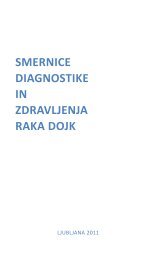You also want an ePaper? Increase the reach of your titles
YUMPU automatically turns print PDFs into web optimized ePapers that Google loves.
Increased tumour hypoxia and morphological blood vessel changes in<br />
tumours after electrochemotherapy<br />
Andrej Cör1, Mateja Legan1, Simona Kranjc2, Maja Čemažar2, Gregor Serša2<br />
1Institute <strong>of</strong> Histology and Embryology, Medical Faculty, University <strong>of</strong> Ljubljana, Korytkova 2, Ljubljana,<br />
Slovenia; 2Institute <strong>of</strong> Oncology Ljubljana, Zaloška 2, Ljubljana, Slovenia<br />
It is widely accepted that no solid tumour can grow larger than a critical size <strong>of</strong> ~ 1mm3<br />
without developing a blood supply network. Tumour vascular networks are chaotic,<br />
featuring complex branching patterns and a lack <strong>of</strong> hierarchy. Vessel diameters are irregular<br />
and blood flow rates are low (1). Evidences has accumulated showing that up to 50-60% <strong>of</strong><br />
locally advanced solid tumours may exhibit hypoxic and/or anoxic tissue areas, which are<br />
heterogeneously distributed within the tumour mass.<br />
The underlying mechanism <strong>of</strong> electrochemotherapy is electroporation <strong>of</strong> the cell<br />
membrane, which facilitates access <strong>of</strong> poorly or non-permeable molecules into the<br />
tumour cells. Additionally to the well-established direct cytotoxic effect on tumour cells,<br />
blood flow measurements showed an immediate reduction <strong>of</strong> tumour blood flow after<br />
application <strong>of</strong> electric pulses and electrochemotherapy (2).<br />
In our study, SA-1 solid subcutaneous sarcoma tumours in A/J mice were treated by<br />
bleomycin (BLM), the application <strong>of</strong> electric pulses (8 pulses, 1040V, 100 μs, 1Hz) or a<br />
combination <strong>of</strong> both – electrochemotherapy. At various time points after therapy, tumours<br />
were excised and analysed histochemically and immunohistochemically with antibodies<br />
against CD-31 as endothelial cell marker, Glut-1 as intrinsic hypoxic marker and active<br />
casapase-3 as apoptotic marker.<br />
After application <strong>of</strong> electric pulses alone, as well as after electrochemotherapy, the extent<br />
<strong>of</strong> tumour hypoxia, detected by Glut-1, reached its peak after 2h and lasted up to 8h after<br />
the treatment. After the application <strong>of</strong> electric pulses, the recovery to pre-treatment level<br />
lasted 14h, whereas<br />
p9<br />
after electrochemotherapy the recovery to pre-treatment level did not<br />
occur for at least 48h.<br />
To discover the cause <strong>of</strong> the increased hypoxia in the tumours after therapy, the<br />
morphological characteristics <strong>of</strong> small tumour blood vessels were analysed. Changes in the<br />
endothelial cells’ shape were observed 1h after the application <strong>of</strong> electric pulses. Endothelial<br />
cells were rounded up and swollen, and the lumens <strong>of</strong> blood vessels were narrowed. The<br />
same blood vessel morphological changes were also found after electrochemotherapy,<br />
although at later times, approximately 14h after electrochemotherapy, some endothelial<br />
cells with apoptotic characteristics and immunohistochemical active caspase-3 positivity<br />
were found. Apoptotic endothelial cells were not observed in tumours treated with electric<br />
pulses alone.<br />
Our results demonstrate that electrochemotherapy also has a vascular disrupting action,<br />
which can greatly increase the hypoxia in the tumours.<br />
References:<br />
1. Tozer GM, Kanthou C, Baguley BC. Disrupting tumour blood vesels. Nat Rev Cancer 2005; 5: 423-33.<br />
2. Sersa G, Jarm T, Kotnik T, et al. Vascular disrupting action <strong>of</strong> electroporation and electrochemotherapy<br />
with bleomycin in murine sarcoma. Br J Cancer <strong>2008</strong>; 98: 388-98.<br />
91
















